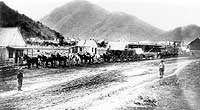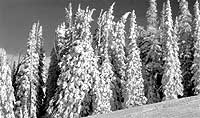

|
Page
171
|
 |
| Ketchum Fast Freight Line, about 1890. View looks west across the Wood River and up Warm Spring Creek near site of the Oregon Short Line passenger station. Photo number P-1100, Palmer Lewis Collection, Community Library, Ketchum, Idaho; used by permission. |
 |
| Naturally flocked trees, Sun Valley ski area (Jan. 1995). |
Sun
Valley Resort
W. Averill
Harriman, Chairman of the Board of the Union Pacific Railroad, arranged that
Count Felix Schaffgotsch (an Austrian) should tour in 1935 the areas in the
Rocky Mountains served by the railroad to locate a site for a resort to serve
the newly growing sport of alpine skiing. Although the southern Wood River Valley
is open, bare, and hardly alpine, the valley narrows to the north at Ketchum
and the hills boast spectacular vistas of the Boulder, Pioneer, and Smoky Mountains.
Harriman bought the 3,888 acre Brass Ranch where the Sun Valley resort is located for $10.04 an acre in spring 1936. He proceeded to build a luxury resort where, in his words, "There isn't a single thing I could wish for that hasn't been provided." The Lodge cost $1,500,000 and was completed in December of that year. It was to become a resort for the rich and famous. In the last ten years, the area has grown faster than any nearby part of Idaho. Many say it resembles a piece of California transported to the Wood River. The transformation from slow and shabby Idaho ranch town to modern resort replete with million dollar homes occurs in distinct steps as one drives north from Carey to Picabo to Gannet to Bellevue to Hailey to Ketchum to Sun Valley. The first time along the road is a strange trip for an Idahoan.
Shoshone
As settlers
began spreading throughout southern Idaho, some gathered at a spot along the
Little Wood River. They called the community Bottoms. A few years later plans
were announced by Oregon Short Line Railway Company to build a railroad through
southern Idaho and this road would pass through the community. By late 1882,
when the railway reached the town, it applied for a post office, to be named
Naples.